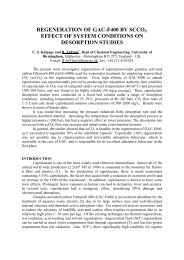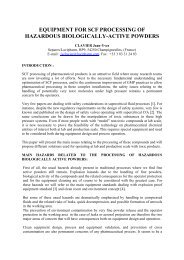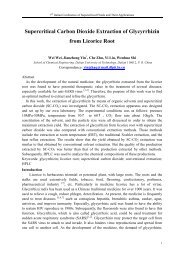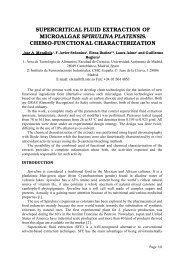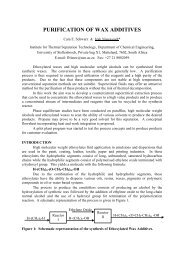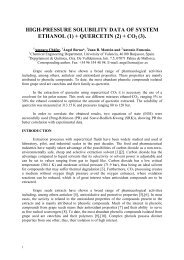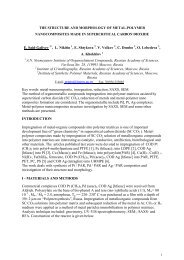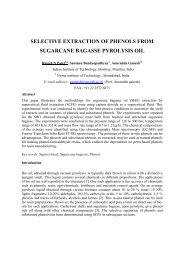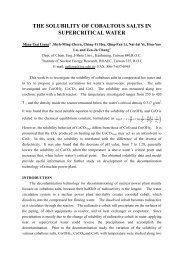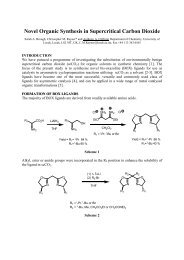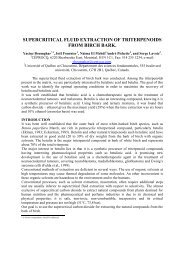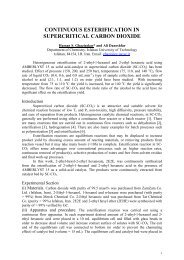EXTRACTION AND ISOLATION OF INDOLE ALKALOIDS ... - ISASF
EXTRACTION AND ISOLATION OF INDOLE ALKALOIDS ... - ISASF
EXTRACTION AND ISOLATION OF INDOLE ALKALOIDS ... - ISASF
Create successful ePaper yourself
Turn your PDF publications into a flip-book with our unique Google optimized e-Paper software.
patients infected with leishmania parasite. The alkaloids extracted from Tabernaemontana<br />
catharinensis (syn. Peschiera australis), showed potent in vitro antileishmanial activity, and<br />
thus, is a potential candidate for leishmaniasis therapy [4].<br />
The yields obtained by the low pressure organic solvent extraction are very low, thus<br />
supercritical extraction can be an advantageous process. In this work is presented one<br />
methodology to estimate the cost of manufacturing the alkaloidal fraction obtained from the<br />
Tabernaemontana catharinensis. The cost of fractionation of the extract was also take into<br />
account.<br />
MATERIAL <strong>AND</strong> METHODS<br />
Raw Material Preparation<br />
Thin branches and leaves from Tabernaemontana catharinensis were collected by<br />
FIOCRUZ (RJ, Brazil) at Campinas region (SP, Brazil). The raw material was dried at<br />
ambient conditions under the shadow and subsequently triturated. Afterwards, the raw<br />
material was transferred to LASEFI – DEA / FEA – UNICAMP, conditioned under vacuum<br />
in plastic bags and stored in a domestic freezer (Metalfrio, double action, São Paulo, Brazil) at<br />
–15 ºC. The size distribution of the particles was determined using a mechanical agitator<br />
(Abrosinox, Granutest, Santo Amaro, Brazil) with the rheostat set at 10 during 10 minutes.<br />
Sieves of 24, 32 and 48 mesh (Tyler series) were used.<br />
SFE Experimental Procedure<br />
The experimental runs were conducted using a SFE unit containing of an extraction<br />
cell of approximately 221×10 -6 m 3 (length of 37.5×10 -2 m and inside diameter of 2.74×10 -2 m)<br />
and maximum pressure of 400 bar described by Pasquel et al. [5]. The data were taken at total<br />
solvent flow rate of 6.1×10 -5 kg/s, 300 bar, 45ºC, using ethanol as co-solvent (9.2% m/m), and<br />
the methodology described by Pereira [6].<br />
Fractionation of the SFE extract<br />
The SFE extract (CE) was dissolved in HCl 5% (fumigating 37%, Merck, P.A.) and<br />
washed three times with hexane (Merck, P.A., lot K26803774934), to remove wax and lipidic<br />
compounds (HE). The aqueous extract was alkalinized with NH 4 OH (25%, P.A., Merck) and<br />
washed three times with chloroform (Merck, lot K2835045, P.A.), obtaining two fractions:<br />
the organic fraction or alkaloidal fraction (AF) and aqueous fraction (AqE). The alkaloidal<br />
fraction was evaporated using a rotary evaporator (Laborota, model 4001, Viertrieb,<br />
Germany), with vacuum control (Heidolph Instruments GMBH, model Rotavac control,<br />
Viertrieb, Germany), bath at 40ºC of the thermostatic.<br />
ECONOMICAL ANALYSIS<br />
The cost of manufacturing is influenced by a series of factors that can be divided into<br />
tree categories: direct costs, fixed costs, and general expenses. The direct costs take into<br />
account expenses that depend directly of the production rate. Some of the items that<br />
contribute to direct costs are the raw materials, utilities, and operating labor, among others.<br />
The fixed cost does not directly depend on the production rate and must be considered even if<br />
the operation is interrupted. Examples of the items that are included in this cost are the<br />
depreciation, taxes and insurance, etc. General expenses are overheads of the plant needed to<br />
maintain the business and consist of the administrative cost, sales expenses, research and<br />
development.<br />
In this work the methodology of Turton et al. [7] was used to estimate the



